
A New Lease of Life
National Mineral Development Corporation
As the country’s largest producer of iron ore, National Mineral Development Corporation (NMDC) is always exploring avenues to give back to the society. With a focus on developing tribal belts, it has a slew of initiatives around its units
Operating three hi-tech and mechanised mines in Chhattisgarh, Karnataka and Madhya Pradesh, NMDC Limited was founded in 1958. It is bringing about a remarkable transformation at the grassroots in the lives of people residing close to its mining units, comprising sensitive tribal belts. The projects are primarily focussed on education, health, infrastructure, animal husbandry. Chairman and Managing Director N. Baijendra Kumar elucidates, “The CSR initiatives of NMDC adopt a flexible, inclusive, process-oriented approach to enable the stakeholders to determine the scope of our programmes and activities. NMDC has shown that it is possible to be profitable while being socially and environmentally responsible.”
SNCU Ward in District Hospital, Dantewada: The district had an alarming Infant Mortality Rate (IMR) due to lack of facilities. So in 2016-2017, the Company built a Sick Newborn Care Unit at a cost of Rs 67.63 lakh. Offering individualised clinical care for the new born, it also serves as a teaching and training centre for doctors and nurses. Meenakshi, a nurse, says, “About 30-35 new babies are born every month in this hospital and at present eight babies have been kept in the special Continuous Positive Air Pressure cribs. There is a dedicated room for mothers to feed their babies which is monitored by us.”
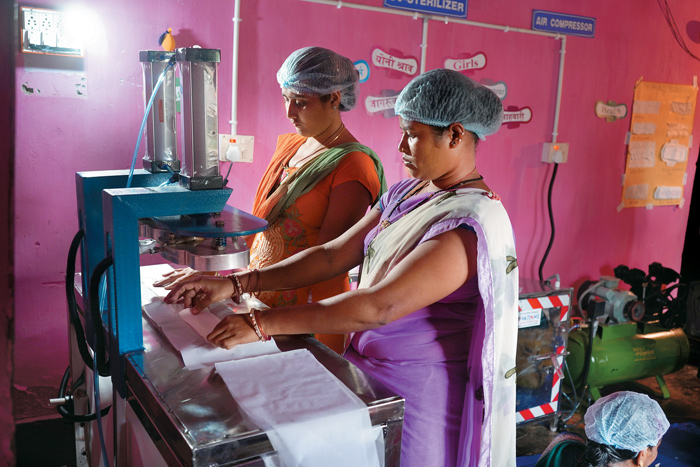
Menstrual Health Management (MHM), Dantewada: Menstrual days being a cultural taboo, young girls and women would never come out in the open about their discomfort. But the district administration in partnership with NMDC, National Rural Livelihood Mission (NRLM) and Department of Women and Child Welfare started a programme to provide sanitary napkins to women and encourage them to earn a livelihood manufacturing these under the Self Help Group (SHG) initiative. MHM has impacted the lives of 11, 746 tribal women in Dantewada till date. NMDC gave a funding of Rs 1.35 crore. S. Alok, CEO, Zila Panchayat, elucidates, “According to studies, the use of sanitary napkins enhances a woman’s life by 10 years and prevents 68 diseases. This was most crucial for pregnant mothers. We began the scheme at Dantewada and it is now being implemented in other districts also.
Adds Aspirational District Fellow, Prakash
Rao, “Sanitary napkins were distributed free for a year. In the last three
months, 8,414 packets have been distributed in tribal areas and educational
department benefitting over 20,000 women across 15 gram panchayats.”
Kumari
Yashoda Guha, who works at the centre, informs that on an average 200
biodegradable sanitary napkins are made per day. Under the project, each of the
seven centres gets raw material for 90 days and Rs 24 lakh initially.
Nikita and Anita are the master trainers at the Chitalur centre. “The first machine for handmade napkins was installed at this centre. At that time, only 35-36 packets could be made per day. Now, with the new machine 250 pieces are made in one day,” says Anita. Nikita adds that it was difficult initially as villagers would threaten them, but “Rao sir allayed our fears. We have sold sanitary napkins worth Rs 80,000 till now. Out of this fund, we purchased raw material worth Rs 30,000. Our earning ranges from Rs 4,000-Rs 11,000 per person, depending on the hours the person puts in. There are 23 such SHGs”.
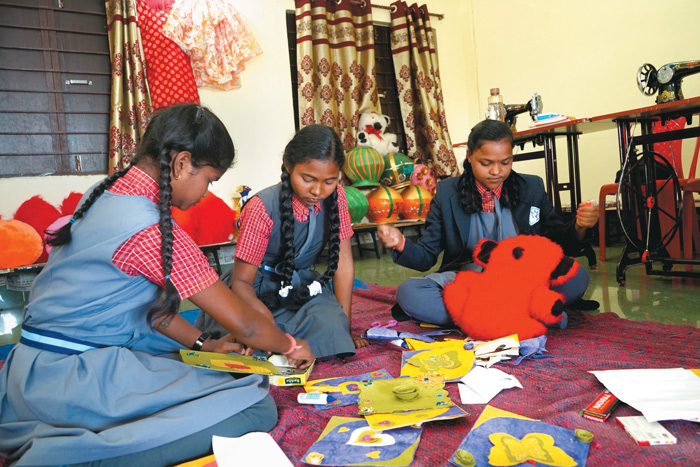
Students in the arts and crafts classroom of Saksham II, Geedam
Hospital on Wheels (HOW), Karnataka: The
medical unit from
‘NMDC Yashoda Arogiyavardini Hospital’ visits one village daily to examine
patients and distribute free medicines to the eight villages surrounding the
project. This project was launched in 2009-10 with an annual outlay of Rs 17
lakh. Free medical camps are also held.
Drinking Water Facilities,
Karnataka: The Company helped
mitigate the drinking water problem in villages of Bellary
district. Along with the state authorities, RO plants were installed
at Sandur, Kuditini and Toranagallu during 2016-17, costing Rs 60
lakh. During 2014-15, a RO plant, costing Rs 1 lakh, was provided
at Kammathur village. The Company has also dug borewells,
provided pumps, pipes and other accessories for uninterrupted
drinking water supply.
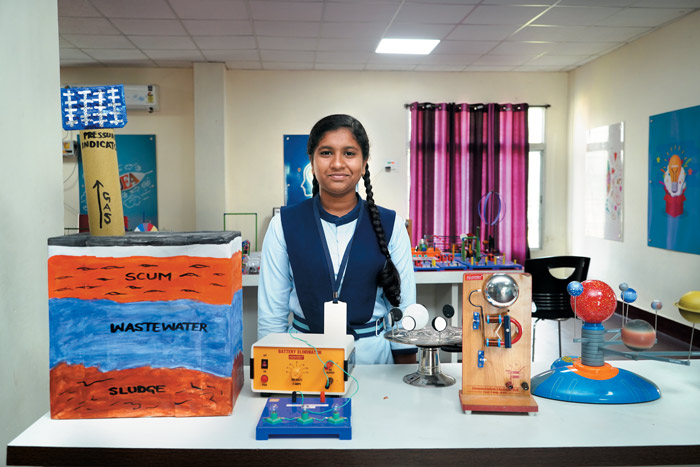
Indu Manikpuri,the bright student, at the lab in Aastha,Geedam
Chhoo lo Asmaan, Dantewada: Under this project, students living in the remote regions get access to a residential academic cum coaching centre. This is for meritorious students studying in classes 9th, 10th, 11th and 12th. They are helped with coaching for national pre-entrance tests such as PET/PMT. This initiative began in 2011 with an investment of Rs 4 crore. Yamini Podiya,from neighbouring Kirandul, has studied at the centre from class 9. Padma Made of Bijapur and she are keen on becoming doctors.Manoj Kumar Srivastava, who coaches students in Physics for JEE Advance and PMT, has been contributing to this initiative for the last two years to bring out the talent of children of this tribal belt of Chhattisgarh.
B.S. Tati, nodal officer for the institution, informs, “Around 3,000 students vie to get admissions here every year with thequalifying cut-off marks ranging from above 60-70 per cent and 58 per cent for ST candidates. Till now around 200 students have got admission to premier medical and engineering colleges in the state and other parts of the country such as National Institute of Technology (NIT), Indian Institute of Technologies (IIT), besides B. Pharma, B.Sc., (Nursing) and graduate course in Agriculture.” The centre also provides counselling for the students. The Karali campus has 317 girls and the Balud campus caters to 315 boys.
Nikita and Anita are the master trainers at the Chitalur centre. “The first machine for handmade napkins was installed at this centre. At that time, only 35-36 packets could be made per day. Now, with the new machine 250 pieces are made in one day,” says Anita. Nikita adds that it was difficult initially as villagers would threaten them, but “Rao sir allayed our fears. We have sold sanitary napkins worth Rs 80,000 till now. Out of this fund, we purchased raw material worth Rs 30,000. Our earning ranges from Rs 4,000-Rs 11,000 per person, depending on the hours the person puts in. There are 23 such SHGs”.
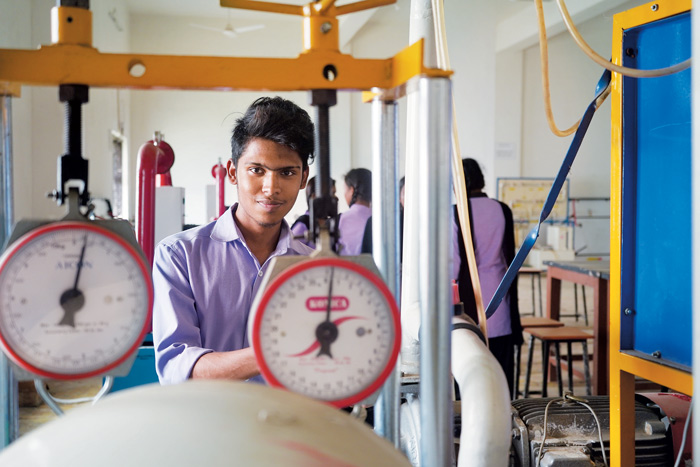
An electrical engineering student at the NMDC Polytechnic, Geedam
Aastha Vidhya Mandir, Geedam:This residential English- medium school,
gives education to the children orphaned during the Naxal violence. While
the first preference is to them, children who have lost their parents and
are unable to educate themselves also get admission. With 1,194 students
from the SC/ ST/OBC and other underprivileged communities, this initiative
has transformed Dantewada into a progressive education hub. “It is the first
educational project in the region following CBSE syllabus,” says principal
Santosh Pradhan.
There are smart classes and good science labs. Children
are encouraged to experiment and Indu Manikpuri of class 10, from Kanker
Gaon, has developed the concept of a self-cleaning septic tank. In 2011, Rs
100 crore was invested in building this education city on 150 acres. It also
houses a polytechnic.
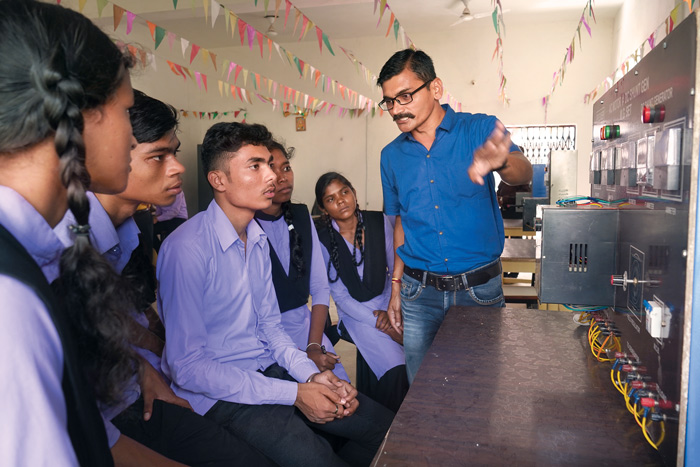
Lab technicianAjay Jain with students at the NMDC Polytechnic, Geedam
NMDC Polytechnic, Geedam, was envisaged as a centre imparting electrical and mechanical technical education to open opportunities for employment. Established in 2010, it is managed by the DAV College Management Committee. A hostel for boys and girls and staff quarters have beeen constructed at a cost of Rs 2,169.71 lakh. Dr Mukesh Thakur, Principal, elucidates that the ratio of students is 40:60, with 40 being girls. Placement is in good companies such as Bajaj Ltd., Ashok Leyland, Yazaki India, Krishna Maruti. With 17 faculty members, each batch has 60 students. “Our institute stands at the third spot for Mechanical and fourth for Electrical in the ranking of best technical centres in Chhattisgarh. We have a well-equipped Language Lab, the only one of its kind in the state, to enable tribal students to improve their English. We also have a good digital library.”
First semester students—Tekashwari, Aarti Yadav, Kritika Poya—studying in the electrical branch, wish to become engineers and help their families. Besides studies, sports are also given importance. Last year, the institute was the Zone 3 topper in sports and other extra-curricular activities with three winners from Bastar region.
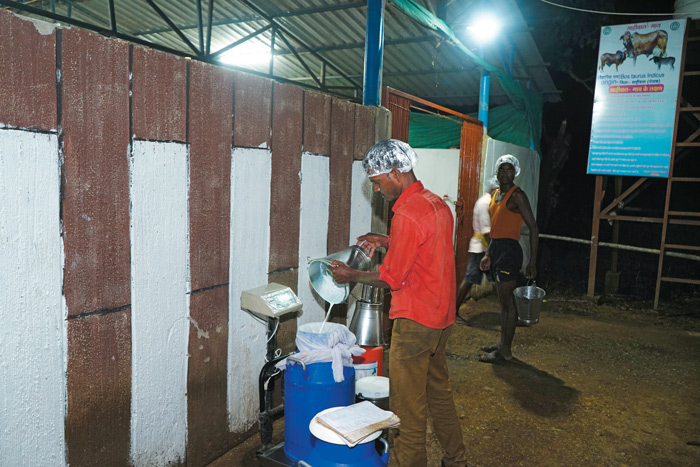
Workers at Dairy Farm & Research Centre, Teknar
Saksham, Geedam: Making the challenged ones independent is this residential school. While Saksham I is for boys, Saksham II is for girls. Currently there are 93 boys and 94 girls here. Children who are visually impaired, hearing impaired, mentally retarded and physically/orthopaedic handicaps, in the age group of 6–14,study here. In 2018-19, Rs 2 crore was earmarked for this.Saksham I, housed in a yellow building, was established on August 15, 2014. Talking about the facilities, Vinay Sonpipre,physiotherapist, says, “The capacity building begins the moment the child reaches the reception where sign language symbols are drawn on the steps. Rhymes, name of birds, animals, flowers are played through the loudspeakers across the building.”
Anand Tewari, Vice Principal, Saksham, points out the dining area where seating arrangements are not uniform. “They are of different levels so that students can sit according to their height. Also, wheelchair-bound children can be easily wheeled to the dining table.” There is a dedicated group hearing room. Learning finance management in a unique way, students run a banking counter and maintain their passbooks which show how they spend their pocket money. “One of our students cleared the CGPET exam in the first attempt, thanks to the smart classes,” says Sonpipre. Dormitories are named after popular figures such as Dr A.P.J. Abdul Kalam, A.R. Rehman. Students with similar talents stay in the dormitory named afer the great figures.
Saksham students, trained under the ‘Hoslon ki Udan’ concept, have won laurels in the district sports. Students gifted in archery are coached by the Eklavya Khel Parishad. At last year’s state championship in Bilaspur, Saksham students won trophies in volleyball, cricket and many other sports. Priyanshi is in class 7 and has overcome a debilitating physical impairment, with only traces of the spastic condition on the left side. Saksham II has art and craft rooms, physiotherapy centre, library for the visually impaired and accessible bathrooms provided with sanitary dispensers. This was inaugurated on January 24, 2015.
Mid-day Meals & Buses, Karnataka:The Donimalai complex is sponsoring the mid-day meal scheme through Akshaya Patra Foundation since 2008-09. It has contributed Rs 88 lakh to provide meals to almost 8,000 children in 32 schools of Bellary District. The benefits have been manifold with reduction in dropouts and improvement in health and nutrition.
The complex is also providing free ‘pick-up and drop’ bus facilities to school children from Kammathur who are studying in Sandur. This facility is also available for students of Navalatti village who are studying in Donimalai Township since 2010-11.
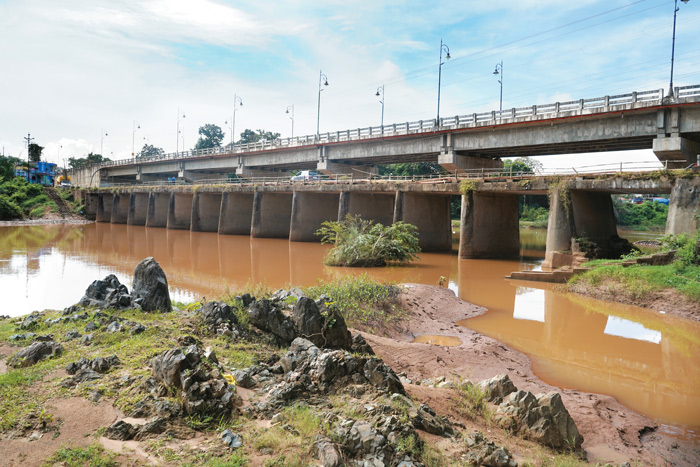
The new bridge built by NMDC over the older one across the Dankini in Dantewada
Gaurav Path, Dantewada:Deprived of railway connectivity, people living in the hinterlands of Dantewada depend heavily on roads for commuting. NMDC understood the need to link Dantewada to other major towns. In partnership with the Government of Chhattisgarh, NMDC constructed the Gaurav Path in 2012-13. The four-lane road, which was built at a cost of Rs 18.31 crore, is 5.6 km long.
High-Level Bridge over Dankini River, Dantewada:With two major rivers, Dankini and Shankini, converging at a certain juncture, monsoon submerged the region. The existing low bridge over Dankini did not help. So, when the people and local administration approached NMDC for support, the Company gave Rs 5.25 crore towards this in 2010-11.
Thanks to the new bridged, built in
partnership with the Chhattisgarh government, people living in the region are no
longer cut off during monsoon.
Tribal Haat-Bazaar Katiyaraas,
Dantewada:With no place to sell their farm produce, the tribals living
in the remotest hamlets were moving away from farming. This is when the district
administration envisaged 19 Tribal Haats. In 2014-15, NMDC spent Rs 3.84 crore
for this. Now, these serve as market links for the people and also have shelters
for their products, particularly perishable items.
Shanti Dham and Nirashita Parihara Kendra, BellaryThe Donimalai Complex, along with district authorities of Bellary,has constructed a shelter-cum-home for those without a place to live. This was constructed at a cost of Rs 863.99 lakh in 2012-13. It has been beneficial for beggars, the mentally challenged,women, elderly people. It has a school for deaf and mute children. And it serves as a correction centre for young boys and girls.
Stadium at Sandur:Giving a boost to sports, a stadium is being constructed at Sandur at a cost of Rs 200 lakh. In the final stage of completion, it will help the youth become sports professionals.
indu maniKpuri, student
Aaastha, Dantewada
The bright Class 10 science student innovates all the time.
"I got full
support from my teachers when I shared the concept of a self-cleaning septic
tank. They helped me build the prototype."
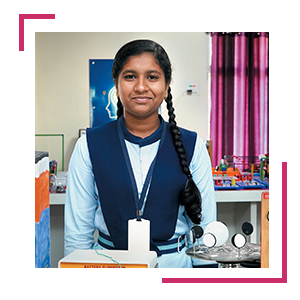
Kumari Yashoda Guha
Mater Trainer, SHG in Mailawada
Her dream of economic independence comes true."It gives me immense satisfaction to skill women so that they can carry forward the good work started by NMDC and NRLM."

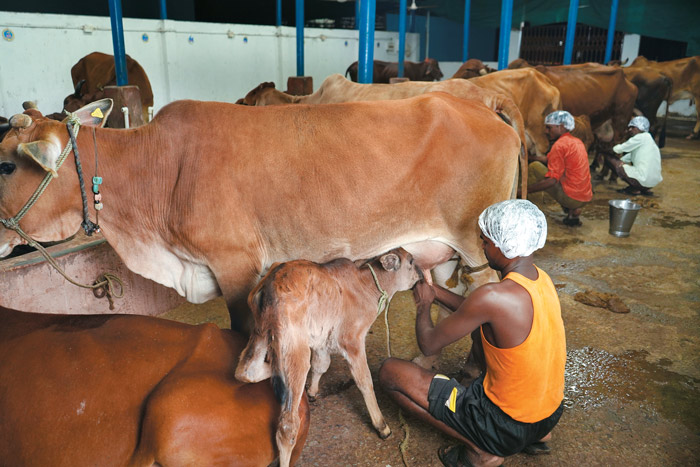
Dairy Farm and Research Centre,
Teknar: A clean space run on technical expertise, this houses 89
cows and one bull. The sprawling area has four cattle sheds with Gir breed
cows from Gujarat, and Saiwal breed from Punjab and Haryana. The cows are
milked in drums that have measurement indicators, to check their
productivity on a regular basis.
The vet, Dr Ajmer Singh, Deputy
Director, Veterinary Services,Chhattisgarh, explains, “We grow enough fodder
in our premises and nothing is wasted. The dung and urine are mixed with
leftovers from the dairy farm and converted into compost. Everything is
organic here. We don’t use any chemicals or pesticides, making our products
the best in Chhattisgarh.”
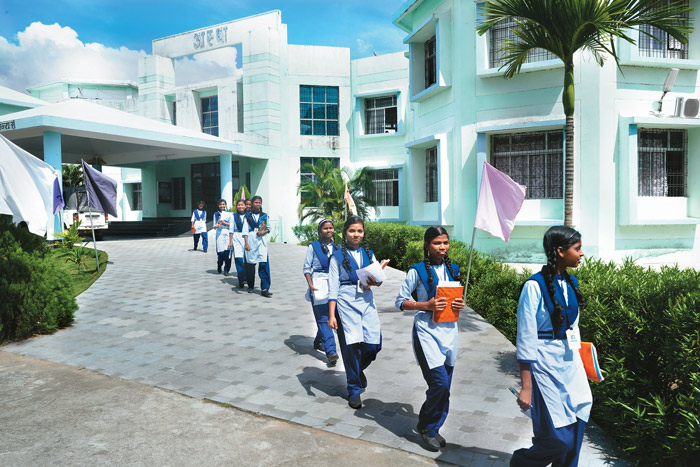
The health clinics in rural areas have been a big relief, especially for women,children and senior citizens
The dairy also has paintings of the blue god Krishna as he loved cows and lived in a village.The dairy has its own vehicles, staff quarters for the caretakers,a multi-purpose hall, a research and study centre. There is a shop in the premises selling dairy products and organic cow ghee sells at Rs 2,000 per kg.
As goats bleat in a shed, S. Alok, CEO, Zila Panchayat, District Dantewada, says, “This herd is to be distributed to the tribal and village folks as a source of livelihood. Each family is given nine goats and a ram. Our approach is community-driven programmes in health, education, agriculture. Gothan and Garva projects were implemented to make the best use of local resources and plough back the benefits into the community. Dantewada has been declared as an organic district and is also tapping renewable energy resources. About 1,800 tube wells here are solar powered.”




